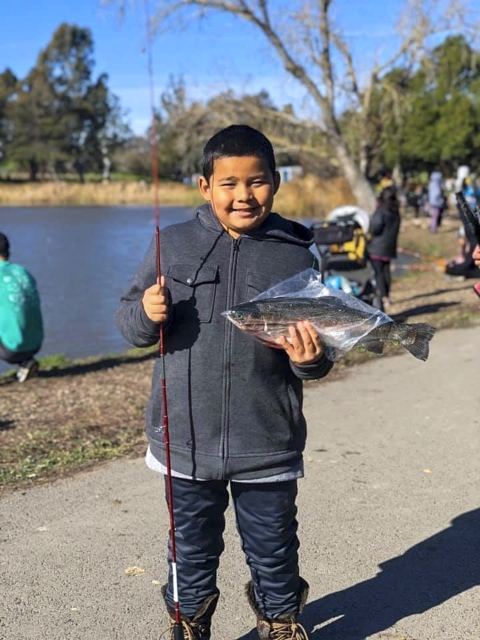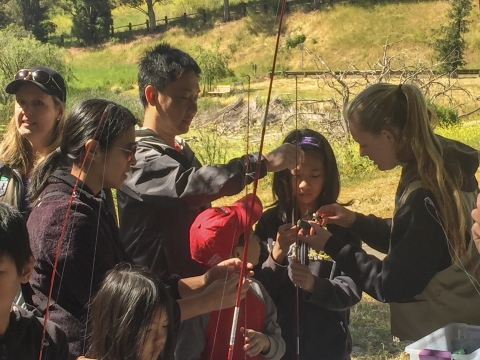California’s Fishing in the City program has a simple goal: to connect people with the outdoors and spark a love for conservation. Teaching people to fish is simply the bait to get them outside.
“People value and protect things that they know,” says Ethan Rotman, Supervisor for the Regional Interpretive Services Department of the California Department of Fish and Wildlife. After decades spent as a wildlife interpreter, he says that establishing an initial connection between urban residents and their local parks and wildlife is crucial. For many urbanites, a visit to a local stream with a fishing clinic will be their first foray into outdoor recreation. Rotman is hoping it won’t be their last.
Fishing in the City
Introduced in 1993, Fishing in the City is a state program that provides a unique opportunity for residents to learn to fish their local streams and ponds. Funded through the U.S. Fish and Wildlife Service’s Wildlife & Sport Fish Restoration’s (WSFR) Sport Fish Restoration Fund, the California Department of Fish and Wildlife-managed program has enjoyed immense success among urban residents.
Fishing has inherent benefits: studies have demonstrated that fishing helps build resilience and boosts both physical and mental health. But Fishing in the City hopes to do more than simply introduce residents to a new sport. Volunteers and wildlife interpreters hold regular clinics with the aim of getting urban residents out into their local parks and spending time together as a community.
The program continues to adapt to a changing playing field. Noting that people are increasingly turning to online platforms to learn new skills, Rotman hopes to meet them there.
He explained that Fishing in the City started publishing short videos online to teach folks basic fishing skills: how to tie a Palomar knot, fillet a fish, or rig a line. “We’re trying to provide our audiences with the tools they need to not only do the activity with us, but then to do it on their own.”
Anglers as conservationists
Fishing has long served as a tool for connecting residents with wildlife, but it also plays a role in fueling conservation efforts. When anglers purchase a fishing license, 100% of the license fees go directly towards conservation and restoration efforts. From protecting endangered species to restoring habitats, fishers and hunters are crucial partners in conservation efforts.
“I’ve always been impressed by all the outdoor opportunities WSFR helps our state fish and wildlife partners provide for the public,” said Justin Cutler, Grants Management Specialist with the Wildlife & Sport Fish Restoration department. “Fishing in the City is one of those programs I’m especially proud to help with. Programs like this provide thousands of people a year with an opportunity to connect with the outdoors and learn to appreciate the value it provides the human soul.
“For me, as an angler and conservationist, there is nothing more rewarding than helping someone get ‘hooked’ on the outdoors,” Cutler added. "The excitement you see in someone catching a fish, especially our youth, tells you that you probably helped make an angler and conservationist for life.”
Urban fishing programs like Fishing in the City aim to inspire the next generation of anglers and break down traditional barriers to access. “If you show up at one of our events, we’re going to provide everything,” Rotman says. “You come to a clinic, we’re going to loan you a rod, we’re going to give you tackle. We provide the bait; we provide the instructions.”
Public education is a central element of the Fishing in the City program. At every fishing clinic, volunteers and interpreters educate the public about ongoing threats to wildlife and urban habitats. As residents learn to fish, they also learn about urban runoff and the role they can play in stopping water pollution.
“There’s a connection between your ability – in this case, to catch a fish – and the quality of water and the actions that we take at home,” Rotman says. “The amount of fertilizer we put on our lawn, whether or not we choose to fix that oil drip from our car, what we pour down the storm drain.”
Building community, one fish at a time
Beyond raising the next generation of conservationists, Fishing in the City aims to strengthen interpersonal bonds through outdoor recreation. At the end of the day, Rotman says fishing is just a tool to get people outdoors and engaged with their communities.
“To me that’s a much more powerful motivator than watching the kid reel in the fish. That’s cool if they catch a fish – great. But to me the motivator is seeing people care for each other, either as community members or family members, and watching them form partnerships.”





